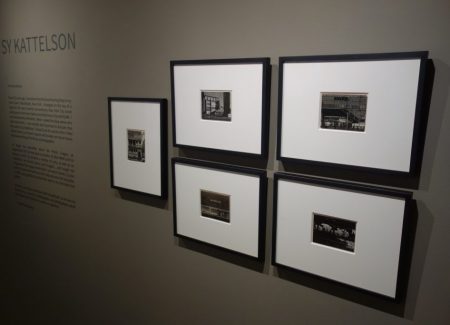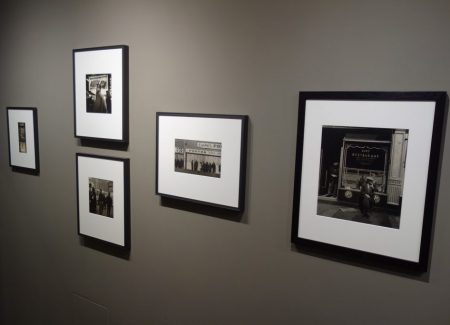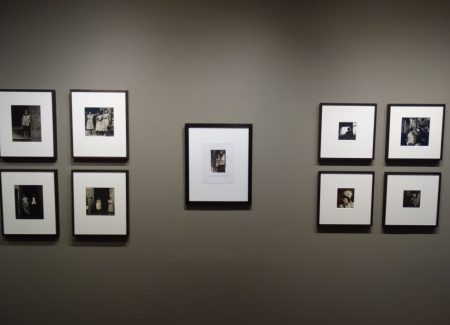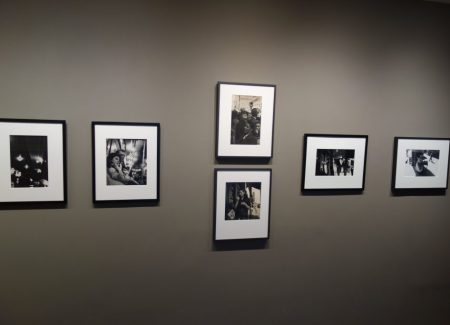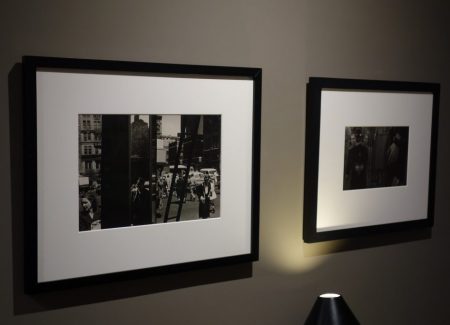JTF (just the facts): A total of 43 black and white and color photographs, variously framed and matted, and hung against beige-brown walls in the second gallery space. The show consists of 33 gelatin silver prints/diptychs, 7 chromogenic prints/collages/diptychs, and 3 carbro prints, made between 1947 and 1990. Physical sizes range from roughly 4×5 to 20×27 (or reverse), and no edition information was provided. (Installation shots below.)
Comments/Context: If I asked you to imagine in your head what the pictures of a lesser known, 1940s and 1950s New York street photographer might look like, I think most of us would come up with a similar set of potential guesses. We might start with a broad sweep of typical subject matter – city storefronts and sidewalks, signs and advertisements, the underside of the now-demolished elevated train tracks and the geometries of bridges, and a consistent supply of pedestrian portraits, of folks lingering in doorways, underneath movie marquees, and riding on the bus or subway, in long dark coats and hats. We would naturally assume the images to be in black and white (perhaps now with the patina of age), and we might expect to find the personality of the photographer to be found in the nuances of his or her choices – the faces, the poses, the clothing, and the tiny gestures that tell us surprising multitudes.
And a quick turn through this show of Sy Kattleson’s street photography from this same time and place confirms nearly all of our suspicions. A member of the New York Photo League who studied under Paul Strand and Sid Grossman, Kattleson was active in the streets in the late 1940s and early 1950s, and his pictures often single out a person or two isolated in the surrounding bustle, where an unguarded, unnoticed moment tells a story of subtle humanity. While the exhibit opens with some crisp architectural studies of Coney Island building facades and infrastructure, Kattleson’s attentive images of faces in the crowd match the stylistic signature of the times.
In picture after picture, Kattleson captures fleeting nuances of attitude. A young man stands amid the flashing lights of Broadway, looking up with vulnerable hope. A young girl stands in a dark doorway with her pocketbook, taking in the stranger with a wary stare. A woman stands on the street smoking a cigarette, looking at the polish on her nails with resigned weariness. Three ladies in printed dresses linger outside a shop, taking in the looks of the passersby with subtle seen-it-all-before skepticism. And a suited man sits on the bus, chomping a cigar with quiet determination. In each scene, Kattleson gets close enough to see the details that make an image into a story.
With these photographs as our guide, it would be straightforward to slot Kattleson in among the other New York Photo League image makers and call it a day – his early pictures were consistently well made and a few of the standouts certainly hold up against the best of his contemporaries. But that neat predictability is upended by a few pictures Kattleson made in the early 1950s, and that’s where this show actually gets intriguing. Something unexpected starts with Man with Cane from 1950 – Kattleson shoots through the glass window of a shop out into the street, the support posts breaking up the image into several sections, the man with the cane moving in the central one. Hand in Window from 1953 plays with a similar window in a different way, reflecting a woman’s face into a double portrait, while bringing the oversized hand of a mannequin inside out into the composition. And 14th Street goes further, making a composite image out of two adjacent frames on a roll, using a ladder outside a shop window to slash through the frame. These works don’t feel at all like traditional street photography – they show signs of experimentation and compositional risk taking. They signal there’s an aesthetic transition of some kind going on here, and that’s what’s worth watching.
By the mid-1950’s, Kattleson’s images had become more focused on motion, with pedestrians seen in unbalanced frames that imply movement across the field of view. And by 1960, he had started to look down, taking in the strides and stances of feet, and printing them in creamy carbro color.
More recent works from the 1980s and 1990s connect back to those first compositional revolutions from the early 1950s, letting those ideas run out in several directions. Two frame color diptychs reconsider the interplay of forms, from the angled reflections of bus windows that converge like lines of perspective to the parallel verticality of a walking shadow and dangling fingers. These ideas are then expanded in black and white diptychs from a few years later that rely on reflected surfaces to entangle street views and soaring skyscraper forms.
This deliberate mixing of imagery seems to have become top of mind for the artist, as about the same time, Kattleson started making layered cut collages, where street scenes come apart, with rectangular areas dropping away to reveal other perspectives underneath. Multiple exposure images also found their way into his visual vocabulary, the layering of building silhouettes and painted street markings done in camera rather than with discrete prints.
All of this later activity points to restless (and ongoing) photographic engagement with the surface of the city. So rather than pigeonhole Kattleson as a certain kind of history book Photo League photographer, this broader career sampler encourages us to see street photography as an evolving genre, where the urban imperative of constant change forces its photographers to continually reinvent themselves. That Kattleson could bridge from the sensitively observed street portraits of his early career to the angular multi-image cacophony of his later work says that he was willing to challenge himself to artistically adapt to new circumstances and new ways of seeing. That’s a dangerous high wire act few artists manage with grace, and it’s this unexpectedly dogged commitment to going further that makes this quiet show so engaging.
Collector’s POV: The works in this show are priced between $4500 and $10000. Kattleson’s work has little secondary market history, so gallery retail likely remains the best option for those collectors interested in following up.
